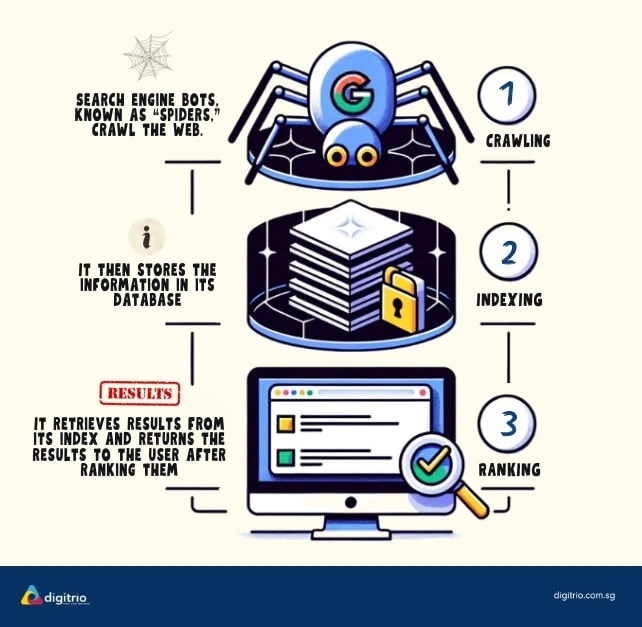Discover how harnessing the power of Web 2.0 platforms can revolutionize your SEO strategy and propel your website to success.

Image courtesy of via DALL-E 3
Table of Contents
Introduction to Web 2.0 and SEO
We’ll kick off by explaining the basics of Web 2.0 and how it can benefit Search Engine Optimization (SEO) efforts. Understanding these concepts is essential for anyone looking to enhance their website’s visibility online.
What is Web 2.0?
Web 2.0 refers to the second generation of the internet, characterized by interactive websites that encourage user participation and collaboration. Examples include social media platforms like Facebook, Twitter, and Instagram, where users can create and share content with others. This shift towards user-generated content marks a significant departure from the static web pages of the past.
What is SEO?
SEO stands for Search Engine Optimization, which involves optimizing your website to rank higher on search engine results pages like Google. By incorporating specific keywords, improving site speed, and enhancing user experience, you can increase your website’s visibility and attract more organic traffic.
Why Web 2.0 Matters for SEO
Utilizing Web 2.0 principles can play a crucial role in enhancing your website’s SEO performance. By leveraging interactive platforms and user-generated content, you can improve engagement, drive more traffic to your site, and ultimately boost your search engine rankings. Embracing Web 2.0 practices is key to staying competitive in the digital landscape.
Benefits of Web 2.0 for SEO
Web 2.0 brings several advantages for boosting your website’s SEO. Let’s explore how these tools and techniques can help improve your online presence.
Improving Website Traffic
By utilizing Web 2.0 platforms like social media, you can attract more visitors to your website. Sharing your content on platforms such as Facebook, Twitter, and Instagram can reach a wider audience and drive traffic back to your site.
Boosting Engagement
User interactions on Web 2.0 platforms can significantly increase engagement on your website. Encouraging likes, comments, and shares can create a sense of community around your content, keeping visitors coming back for more.
Enhancing Visibility
Implementing Web 2.0 techniques can improve your website’s visibility in search engine results. By creating engaging content that resonates with your target audience and optimizing it for SEO, you can increase your chances of ranking higher on search engine pages, making it easier for users to find your site.
Techniques for Using Web 2.0 for SEO
When it comes to improving your website’s visibility and ranking on search engines, employing effective Web 2.0 techniques can make a significant difference. Here are some key strategies to optimize your site for better SEO results:

Image courtesy of www.slaterockautomation.com via Google Images
Creating Quality Content
One of the most crucial aspects of enhancing your site’s SEO is creating high-quality and engaging content. Search engines prioritize websites that provide valuable information to users. By crafting compelling blog posts, articles, and other forms of content, you can attract more visitors and increase your site’s credibility.
Using Social Media Platforms
Social media platforms like Facebook, Twitter, and Instagram are powerful tools for boosting your SEO efforts. Sharing your content on these platforms not only increases your website’s visibility but also drives traffic back to your site. Engage with your followers, encourage sharing, and participate in relevant conversations to expand your reach.
Networking with Influencers
Connecting with influencers in your industry can significantly enhance your SEO strategy. Influencers have a loyal following that trusts their recommendations, so partnering with them can expose your website to a broader audience. By collaborating on content, guest posts, or promotions, you can leverage their influence to increase your site’s visibility and credibility.
Creating User-Generated Content
In this section, we will explore how user-generated content plays a crucial role in enhancing SEO outcomes by involving your audience in creating valuable content for your website.
Encouraging Comments and Reviews
To boost user-generated content, encourage your audience to leave comments and reviews on your website. Comments provide fresh, unique content that can improve your site’s SEO. Responding to these comments also helps in building a sense of community and engagement among your visitors.
Hosting Contests and Giveaways
Another effective way to generate user content and increase engagement is by hosting contests and giveaways on your website. Encourage users to participate by submitting their own content, such as photos or videos, related to your brand or products. This not only generates user-generated content but also creates excitement and interest around your brand, increasing visibility and driving traffic to your site.
Introduction to Social Bookmarking
Social bookmarking is a method of saving and organizing website links online. It allows users to bookmark, tag, and share interesting content with others on various online platforms. This can be a great way to discover new websites and articles that others find useful.
Popular Social Bookmarking Sites
Some popular social bookmarking sites include Reddit, Digg, StumbleUpon, and Delicious. These websites allow users to save and share links, vote on content, and discuss various topics. By engaging with these platforms, you can increase traffic to your website and improve its visibility online.
Benefits of Social Bookmarking
Social bookmarking can benefit your website in several ways. Firstly, it can drive additional traffic to your site as users discover and share your content. Additionally, when users bookmark your site on these platforms, it can improve your search engine rankings. This is because search engines like Google see these bookmarks as a form of social proof that your content is valuable and relevant.
Utilizing Blogging Platforms
When it comes to boosting your website’s SEO, selecting the right blogging platform is crucial. Platforms like WordPress and Blogger offer user-friendly interfaces and a variety of customizable options. Consider your specific needs, such as the ability to customize designs, add plugins for SEO optimization, and integrate social media sharing buttons.

Image courtesy of digitrio.com.sg via Google Images
Optimizing Blog Posts
Optimizing your blog posts for SEO involves thoughtful use of keywords, meta descriptions, and tags. By incorporating relevant keywords naturally throughout your content, you can improve your chances of ranking higher in search engine results. Additionally, optimizing images with alt text and creating compelling meta descriptions can further enhance your SEO efforts.
Engaging with Your Audience
Engagement is key to building a loyal audience and improving SEO. Responding to comments, asking for feedback, and encouraging social media shares can all contribute to increased visibility and traffic. Engaging with your readers not only builds a sense of community but also signals to search engines that your content is valuable and worth ranking higher.
Using Multimedia Content
One exciting way to enhance your website’s SEO is by creating engaging videos. Videos are a popular form of multimedia content that can attract visitors and keep them engaged. When creating videos, make sure they are relevant to your website’s content and provide value to your audience. You can showcase product demonstrations, how-to guides, or even behind-the-scenes footage. Remember to optimize your videos with relevant keywords in the title, description, and tags to improve visibility on search engines.
Introducing Podcasts
Another fantastic multimedia content option to consider for boosting your SEO is starting a podcast. Podcasts are audio recordings that allow you to share valuable information, interviews, or discussions with your audience. By creating podcast episodes that are unique and engaging, you can attract new listeners and drive more traffic to your website. Just like with videos, optimize your podcast titles and descriptions with keywords related to your content to improve SEO.
Enhancing Content with Images
Using images is an effective way to make your content more visually appealing and optimize it for SEO. Including relevant images in your blog posts, articles, and web pages can enhance the overall user experience and make your content more shareable. When using images, ensure they are of high quality, properly sized, and have descriptive filenames. Alt text should also be added to your images to improve accessibility and help search engines understand the content. By incorporating images strategically throughout your website, you can increase engagement and improve your site’s SEO ranking.
Web 2.0 Tools and Resources
When it comes to optimizing your website for search engines like Google, Web 2.0 tools and resources can be valuable assets. These tools help you leverage the power of user-generated content, social media platforms, and other interactive elements to boost your SEO efforts. In this section, we will highlight some essential tools and resources that can aid you in utilizing Web 2.0 for SEO.

Image courtesy of echovme.in via Google Images
Social Media Management Tools
Social media management tools are essential for efficiently managing your presence on various social media platforms. Tools like Hootsuite and Buffer allow you to schedule posts, monitor engagement, and analyze the performance of your social media campaigns. By using these tools, you can streamline your social media efforts and ensure consistency in your online presence.
Content Creation Tools
Creating high-quality content is crucial for effective SEO. Tools like Canva and Grammarly can help you generate engaging and error-free content. Canva offers templates for designing graphics and visuals, while Grammarly assists in checking grammar and spelling errors in your written content. By utilizing these tools, you can ensure that your content is compelling and error-free, enhancing your website’s SEO performance.
Analytics and Monitoring Tools
Monitoring the performance of your website and SEO strategies is vital for making informed decisions and improvements. Tools like Google Analytics provide detailed insights into your website traffic, user behavior, and keyword performance. By analyzing this data, you can identify areas for improvement and optimize your website for better search engine visibility. These tools help you track your progress and adjust your strategies to achieve your SEO goals.
Conclusion
In conclusion, we have explored the exciting world of Web 2.0 and how it can significantly benefit Search Engine Optimization (SEO). By leveraging the interactive nature of Web 2.0 platforms, website owners can enhance their online presence, attract more visitors, and improve engagement with their audience.
Throughout this article, we have highlighted the importance of creating quality content, using social media platforms effectively, networking with influencers, encouraging user-generated content, utilizing social bookmarking, blogging platforms, multimedia content, and leveraging various tools and resources to optimize SEO strategies.
By employing these techniques and embracing the opportunities that Web 2.0 offers, website owners can not only boost their search engine rankings but also establish a stronger online presence and connect with a wider audience.
So, whether you are a budding blogger, a small business owner, or a content creator, incorporating Web 2.0 strategies into your SEO efforts can drive success and help you achieve your online goals.
Frequently Asked Questions (FAQs)
What is Web 2.0?
Web 2.0 refers to interactive websites where users actively participate in creating content. Social media platforms like Facebook, Twitter, and Instagram are examples of Web 2.0 sites where users share photos, videos, and posts.
How does Web 2.0 help with SEO?
Web 2.0 platforms play a crucial role in improving SEO by increasing your website’s visibility. When you share content on social media sites or other Web 2.0 platforms, it can drive more traffic to your website and enhance your online presence, ultimately helping you rank higher in search engine results.
Can I use Web 2.0 for my small website?
Absolutely! Web 2.0 techniques can be beneficial for websites of all sizes, including small businesses. By leveraging social media platforms, user-generated content, and other Web 2.0 tools, you can increase your website’s visibility, engage with your audience, and improve your SEO rankings, even with a smaller website.







